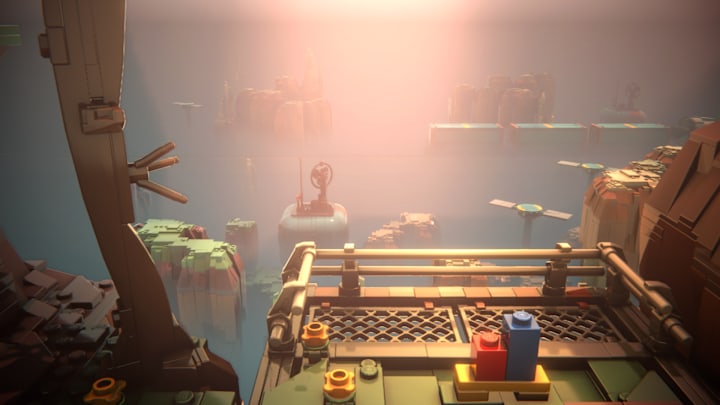Lego Voyagers review: Cozy co-op puzzling as you reach for the stars
By Ryan Woodrow

Lego games tend to fall into two categories. They’re either about action-packed IP worship like all of the Traveller’s Tales games, or they’re weird experimental things that try to put a unique Lego spin on existing genres like Lego Worlds or Lego Builder’s Journey. It’s that second category that always intrigues me the most, and thankfully, the category Lego Voyagers fits into.
This is a co-op 3D puzzle platformer where you play as two little Lego bricks who are exploring the world as they try to complete a very simple and easy goal – launch themselves into space. You’ll be gathering bricks, building bridges, riding on vehicles, and all sorts of other things, as one of Voyager’s biggest strengths is the variety in puzzle design. It never holds on one idea for too long, and is always mixing it up with new mechanics to test you, though not all of these are hits.
My biggest frustration is with the control scheme when building things. On an Xbox controller, you press B to snap onto an object or movable brick – provided it has a stud for your little bricks to connect to. By default, when snapped onto an object, you simply roll around the world with it attached, with the physics system making for some delightfully silly moments as you roll around with jagged shapes that are not even remotely ball-like.
However, when you want to place those blocks, you then need to press B again to snap onto a grid system that lets you easily and precisely place things, which is useful – unless you’re near another block, in which case you’ll snap onto that instead. However, it then gets more annoying as, despite it looking like you’re attached to the bricks below you at that point, if you press A to hop off the block, you’ll discover that it’s not actually attached, because you have to press B again to lock it in place.
It may seem like a small thing, but it’s something that, even at the very end of the game, just doesn’t sink into muscle memory because the visuals make it look like the blocks are attached. It’s not the end of the world, as if a brick falls into a pit, it will reappear moments later, but it leads to a lot of unnecessary faff when you’re building bridges and towers.
That is pretty much all you’ll be building, by the way, bridges and towers, as the game has a limited number of tricks. The puzzles are generally more about overcoming the obstacles to obtain the bricks, rather than asking you to get creative in building things. In this way, there are some fun puzzles involving magnets and weighted see-saws, but it never gets particularly challenging.
That’s not a problem in itself; this is clearly a game designed to be solvable by children, but I was left wanting more in that department. That is, aside from one frustrating mandatory minigame right at the end that blows the difficulty of everything else out of the water. That was perhaps an overcorrection.
As it’s a mandatory co-op game, it does a good job of building puzzles around the idea of you working together. There are a number of puzzles that could clearly be done alone, but the game still mixes in fun sequences where you have to work together, leading to fun banter, which is the kind of thing that makes other games like this so fun, like It Takes Two or Split Fiction.
This is amplified when halfway through the game, one player has a change to their character that allows them to interact with puzzle elements that the other player can’t. Like a lot of things, I don’t think this was used to its full potential, as it often just meant one of you has to stay behind flicking switches while the other person goes off and does the fun things, but it does ensure that you’re communicating and interacting, which is where the whole fun of mandatory co-op play comes from.
The best example is the puzzle where you have to drive a car around a big area to gather bricks, with one of you controlling forwards and backwards, while the other controls left and right. The control scheme for this was also annoying as the relativity of direction in regards to the unmovable camera kept changing, but in a way, that did lead it to be one of the most memorable parts of the game, as me and my co-op partner were bantering and berating each other for our inability to drive in a straight line or constantly getting wedged in tight spaces like we were Austin Powers.
It helps that the whole thing is wrapped up in an adorable package. It earns extra points as a Lego game, as everything in the world is actually made of Lego for once, and it looks fantastic in Unreal Engine 5 as the sun and sky gleam off the reflective plastic of the bricks. Plus, you get to enjoy a sweet little story of these two bricks fulfilling their dream of going to space, even getting to do fun things like design the style of your rocket along the way.
That’s why, even though I have my frustrations with the controls and I was left wanting more from the puzzles, I still very much enjoyed my time with Lego Voyagers. While it had potential for greater things, the puzzles are still good fun and strike at the elements that make co-op play uniquely enjoyable. At a tight three hours, it’s the kind of game you could easily play with your partner or kid to spend a cozy, lazy evening together.
Lego Voyagers. 7. Co-op Puzzle-Platformer. PC. Lego Voyagers
More reviews on DBLTAP:
feed